One day the doctor-hepatologist in Japan
 Bashny.Net
Bashny.Net
Author: Greetings to all! My name Kaharman Esmembetov, I'm a doctor, hepatologist. I invite everyone to plunge into one day of my life in Japan, in Japan, the centuries-old culture and technologies of the future. You will visit the laboratory where loud forged medical discoveries in the department to bypass the Japanese doctors and a Japanese restaurant where they cook exotic dishes. But all this is in order. It will be interesting, I promise!


Sunrise in the Land of the Rising Sun - truly one of the earliest in the world. Upland, constituting more than 75% of the country created during dawn and dusk exciting bizarre picture
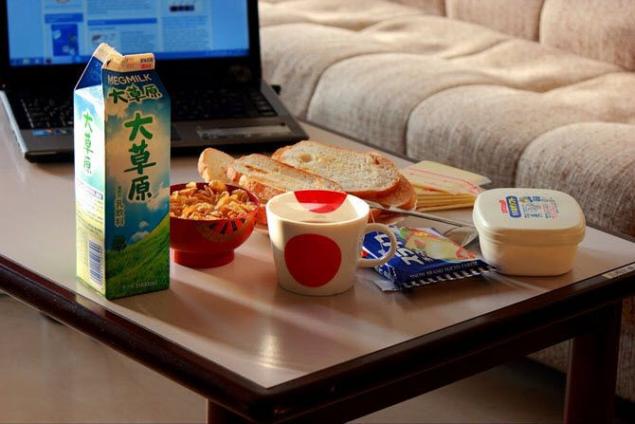
Breakfast bachelor. For lack of yogurt and cottage cheese, must be content with a sandwich, cereal and favorite black tea with milk. "Aperitif" is a proven tool - morning newsletter

Virtually all of the sidewalks along the city roads throughout Japan are paved with tactile paths for the blind. Clinic 3-minute walk and the way you can go along the path, napping, "on autopilot"

National Nagasaki Medical Center (NMC) - one of the largest medical institutions of Kyushu. Center among the remaining 144 such institutions is part of the National Organization of hospitals in Japan. In the 31 department of the clinic center (10-storey building in the photo) at the same time may be more than 600 patients, clinic (3-storeyed building, communicating with the clinic) takes an average of 800 patients a day. Of the total number of permanent staff of 900 people at each of the 182 doctors an average of 3 nurses

"Green" in the literal and figurative sense parking. On my bike I still only here. Bike by the way, provides the clinic. As I have said, a clinic in a 3-minute walk from the house, but I go by bike, but if I have to in the evening to go somewhere

Entry and exit from the NMC maximum thought: some parking for two-wheeled transport avtomobileyi surround clinic with 3 sides, taxi duty front of the main output of the clock, and works like a clock Japanese public transport links the area with important points of the city
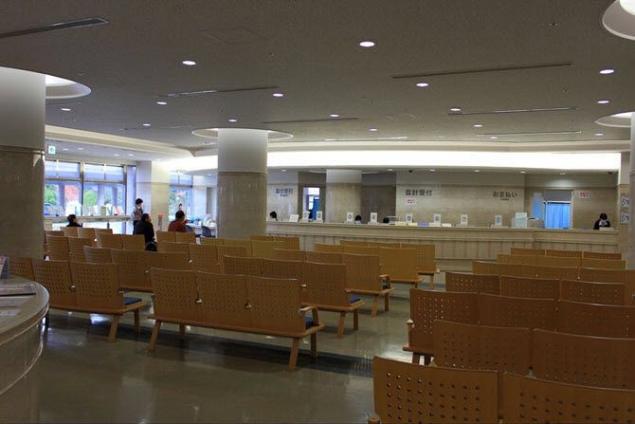
Receptionist clinic early in the morning. Here it is to greet each counter of the staff, regardless of whether you're familiar with him / her or not. "Good morning" in Japanese - "Ohio gozaimasu" greeting is usually accompanied by a bow depending on the status of the acclaimed, from slight nod of the head to a deep bow. Bow in Japan - a kind way of communication, it is not just a greeting, using it also would like to thank and apologize. It's hard to get used to the fact that a handshake is not taken
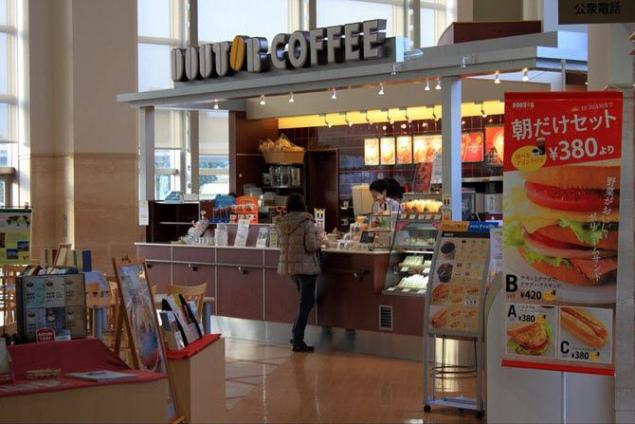
Cup of coffee and a croissant enrich your waiting in the lobby clinics NMC

On the second floor - offices specialists, diagnostic department and a mini-operating
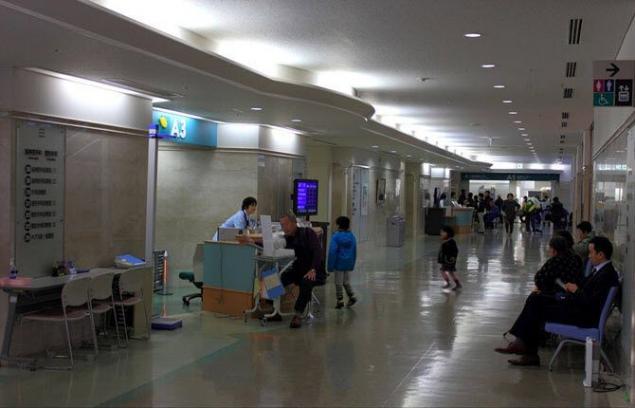
Have specialists on the 3rd floor of the polyclinic life is in full swing
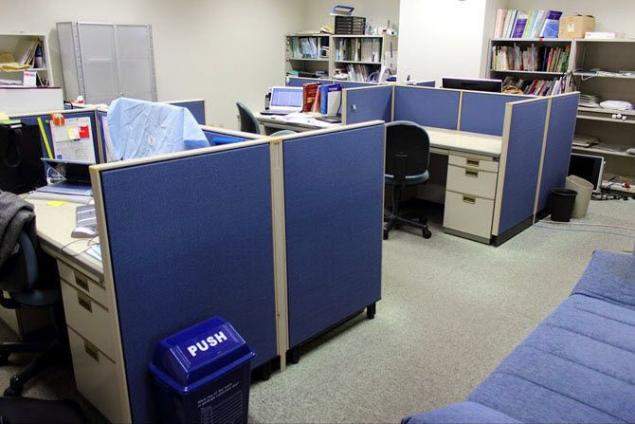
In this office for doctors Clinical Research Centre, located on the 2nd floor of the NMC is my workplace. In the laboratory, a research center I spend his scientific experiments, that is the main purpose of my stay here. I am studying liver disease and biliary tract, particularly the problem of viral hepatitis. This issue is very serious in many countries, but Kazakhstan is on the edge of a peculiar problem - according to the official WHO estimates, our country is a country with a high prevalence of hepatitis B and moderate - Hepatitis C
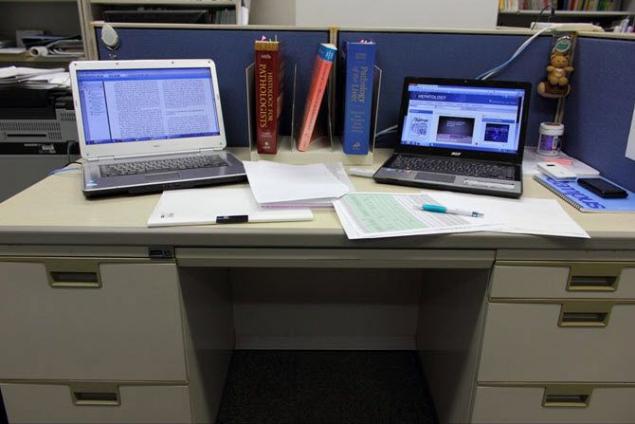
My workplace my eyes. Computer left - treasury, provides access to the local network clinics, to the shared printer and institutovsky online access to articles from leading medical journals in the world. My computer for security reasons to the center refused to connect, so you have to use both. In fairness it should be noted that all the other tables, too, at least for 2 computers for the same reason

Nursing post in the Division of Hepatology at the 8th floor of the clinic. Prior to the daily morning briefing at 8:45 with the head of the experiment time to see the schedule offices today - planned one operation, radiofrequency ablation of tumor focus in the liver and bypass patients. Private nursing room to room, common in clinics post-Soviet space is not here, they simply have no time to sit. Every 8 hours sisters follow each other day of their course more than 37,943,094
Weekly briefing in the office of Director General Clinical Research Center NMC, Professor Ishibashi (center), which controls the execution of all scientific publications in the walls of the clinic. The theme of the briefing - the course of my scientific experiment, discuss progress and next steps. Dr. Migita (left), head of the experiment, with whom I discussed all the working points, gives valuable practical guidance. After the first week of work at the center I have trained to perceive these meetings very seriously, while all painted up to minutes, so weekly briefings - almost the only opportunity to discuss important issues at the same time with both my heads
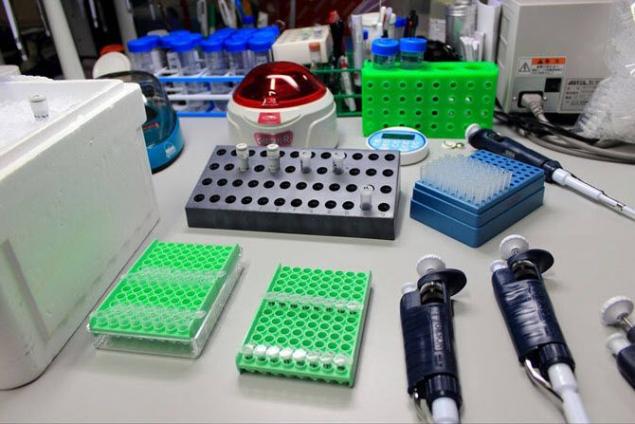
It is known that each person reacts differently to the same hepatitis B virus - some are cured thanks to its own immune system and not even notice it, while others develop chronic hepatitis B with prolonged favorable course, which practically does not prevent live in Third disease in a short time actively progressing to cirrhosis and liver cancer. The purpose of our scientific experiment - an attempt to identify the DNA genetic factors that contribute to an individual's susceptibility to hepatitis B. My mission - to highlight the desired region of DNA from the blood of patients with hepatitis B virus susceptibility coding and testing it for possible changes that can determine the degree of susceptibility to the same virus different people
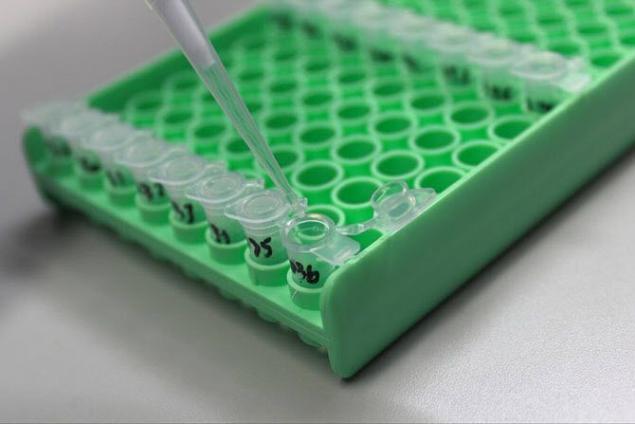
The key to success of the experiment - diligence and accuracy. The reactions are carried out with volumes of material izmeryamym in microlitres, i.e. 1/1000 grams
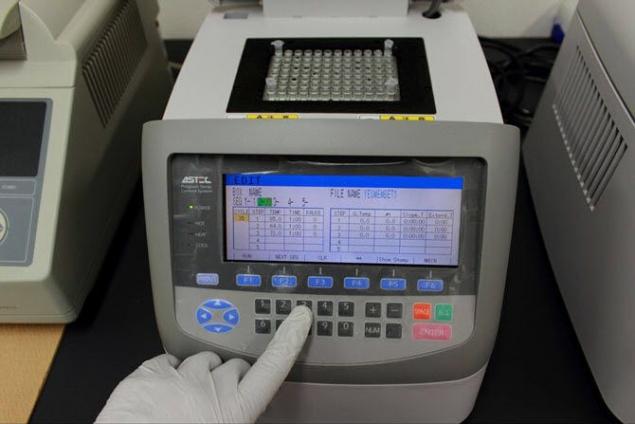
Setting the thermocycler program of polymerase chain reaction (PCR). PCR allows you to copy and almost infinitely increase the amount needed for the study of the DNA fragment. During the reaction, the DNA in test tubes in a thermocycler periodically heated and cooled, allowing you to split a double-stranded structure, selecting and play it until the desired amount of material
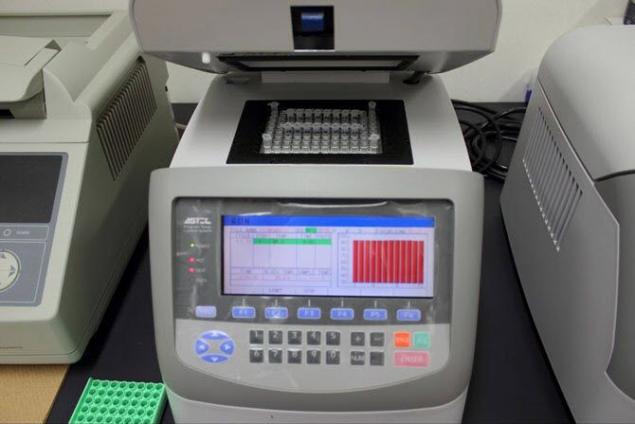
The PCR program is given, the tubes loaded into the preheated to the desired temperature cycler, the apparatus can be run. About 2 hours the reaction product will be ready and you can start the second phase

Implementation of the second phase of the experiment - restriction analysis, new to me. One of the assistants Dr. Migitas long experience of laboratory work helps to avoid the phenomenon of "first pancake"

The final product, obtained by PCR and restriction analysis, electrophoresis is subjected, being immersed in a special gel. During electrophoresis, which was first described by the way in the MSU, move the DNA fragments in the gel, depending on the molecular weight due to the created electric field

The last and most exciting stage - digital processing of the agarose gel with the final product in a fluorescent image analyzer and test results. Minutes for the issue of the result on rereadings from an emotions load comparable to a few hours of painstaking preliminary laboratory work
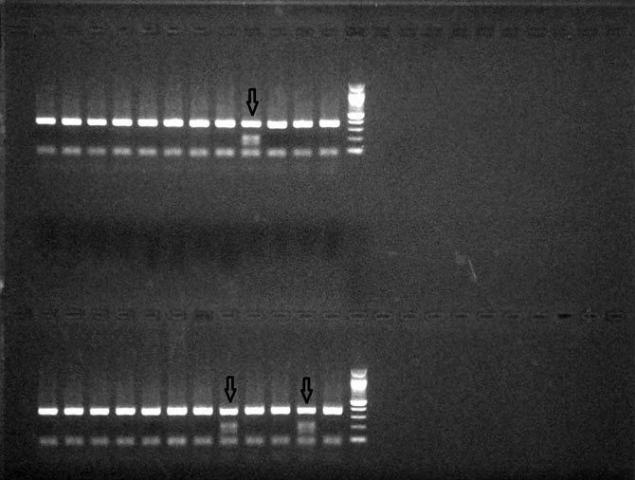
In 3 samples (marked by arrow) revealed changes in the DNA molecule. After processing all the DNA samples of patients with hepatitis B, and there are several hundred, will be held the final analysis of the results, and based on a comparison with similar data from healthy people, summed up eventually. This study has the potential to shed light on the patterns of susceptibility to human hepatitis B virus and the severity of the disease at the genetic level
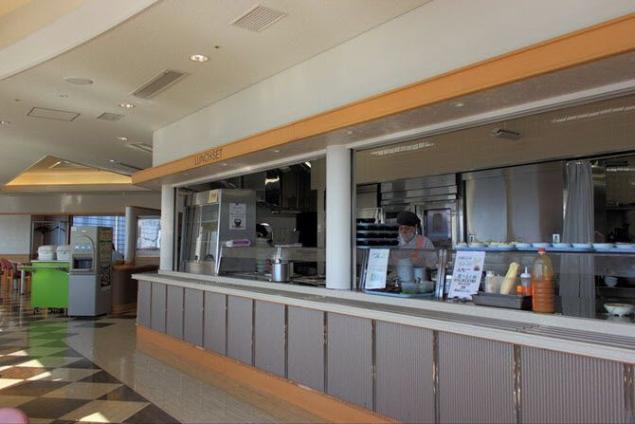
Lunch time in the clinic - from 12 to one in the afternoon, but the time frame is not fixed rigidly. I usually manage to escape home for lunch after an hour, but today every minute counts, and here I am in the dining room for the staff on the 10th floor. My usual menu - salad, miso soup Japanese national, grilled chicken, rice and a glass of water. Price question - 450 yen (about 180 rubles).
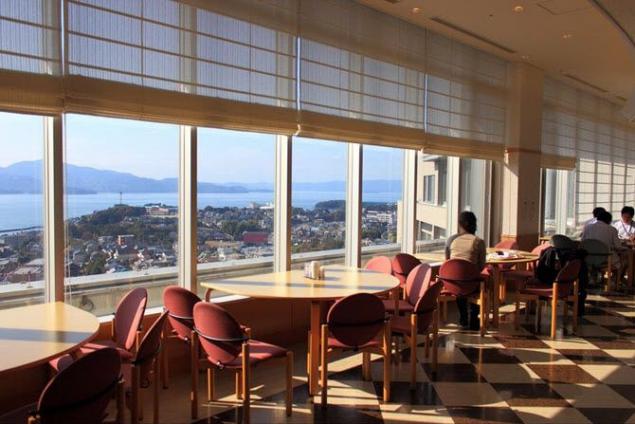
From the windows of the dining room with a breathtaking view of the city and the bay of Omura. Rush hour dinner was held in the dining room and very nelyudno. A few words about the table setting: a choice of sticks ("Hashi") or spoons and forks. There are certain rules for using chopsticks, which I, frankly, found only here in Japan, although eastern restaurants visited quite often: Hashi not be left stuck in rice, is not taken to indicate them to anyone, as well as gestures and cross. Soup to drink, and its contents to eat with chopsticks. At first it was strange to me that the Japanese are very often quite loud smack one's lips when eating soup, we do this with the public is unacceptable
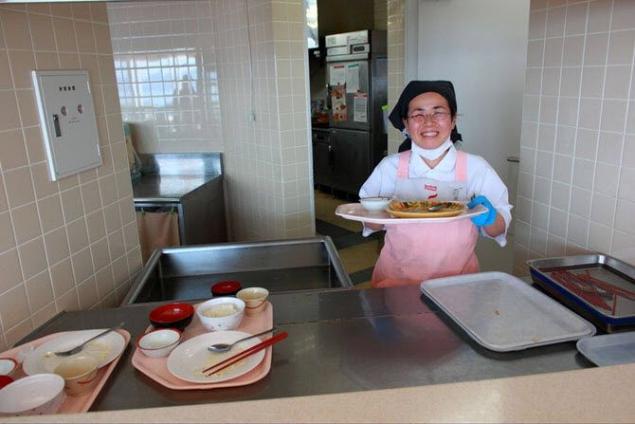
In the cafeteria. Japanese service to pay tribute, generally recognized such sincere hospitality, friendliness and positive mood staff is hard to find anywhere else
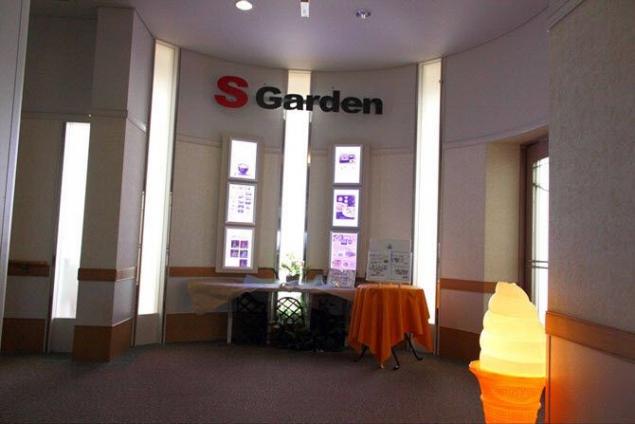
On the 10th floor are also the restaurant for patients (pictured), a hall for tea ceremony-vendor machines for drinks and coin-operated laundry. Last - another proof of the traditional Japanese attention to detail, because for a long time are often close together with patients, especially with seriously ill and the possibility of a much-needed laundry service
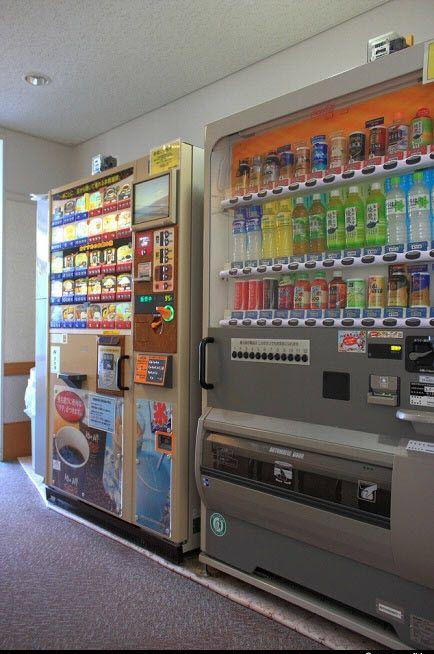
-Vendor drinks machine, in this case as one of the indicators of food culture in Japan. Firstly, these devices are found absolutely everywhere, in every part of the sleepy provincial town in Japan you can be rest assured that you will not feel thirsty (provided that you have in your pockets 100-150 yen - 40-60 rubles). Second, a good half of the range occupied by green teas, which are here in abundance. The other half is represented by mineral water, juices, black tea with milk and coffee with milk (yes, plastic bottles). From carbonated drinks - only the "Coca-Cola", "Pepsi" and sometimes "Fanta»

Pride NMC- helicopter service. In the context of Japan, with its many small islands scattered - is not a luxury but a vital necessity. Now there is a center 2 helicopters, one designed for the transport of emergency patients, and the second is a helicopter taxi for doctors
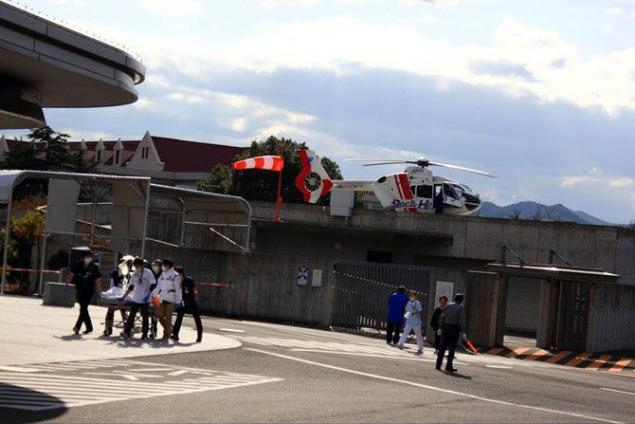
Every year, NMC provides emergency assistance to more than 10 000 patients, of whom about 180 - with the help of helicopters
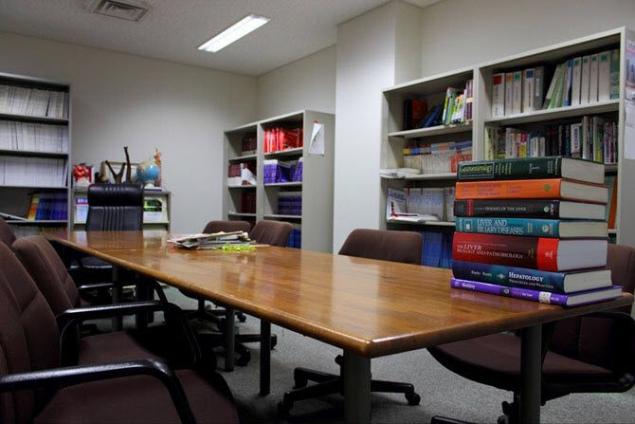
Mini-library in the research center - the dream of a hepatologist. Here in one room contains the most authoritative international publications on Hepatology. Half an hour after lunch before the bypass in Gastroenterological department will be spent here with the use of
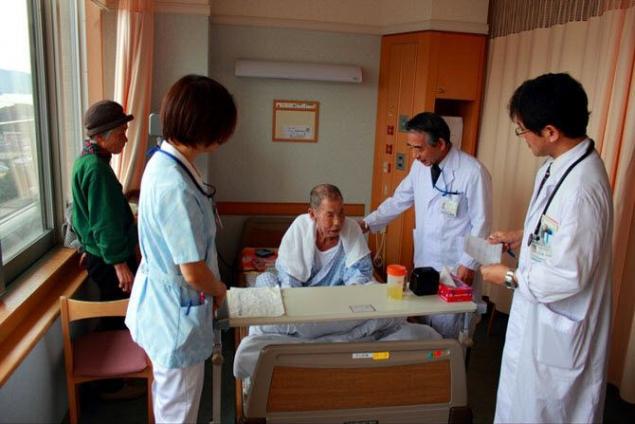
Weekly bypassing the General Director of the Research Center Professor Ishibashi, head of the Department of Hepatology Abiru doctor and senior nurse branch.
M.-san is observed on the separation of cirrhosis in the outcome of hepatitis C more than 15 years. Regular monitoring and inspection can successfully control the disease. Chamber in the photo - the usual 4-seater, which is given to patients by default, due to the free insurance

S. San preparing for elective surgery for radiofrequency ablation (RFA) in the liver tumor focus (see. Description of the operation below). Over the past 8 years he held this procedure 5 times in connection with the appearance of new lesions and each time successfully. Although the patient, this operation is not new, Professor Ishibashi still found it necessary to pay attention to and encourage the patient. Chamber in the photo - Single, for her patients need to pay extra around 5,000 yen per night (about 2000 rubles)

F. Life-san 2 weeks ago literally hanging in the balance due to liver failure. Currently, his condition stabilized. The final touch in the treatment - removal of fluid from the right pleural cavity that has accumulated as a result of ascites (excessive accumulation of her in the abdomen), and we can discuss discharge home. The cause of ascites was liver cirrhosis, in which the normal liver tissue is replaced by fibrous connective tissue (scar tissue) and compacted liver prevents the outflow of blood vessels in the surrounding
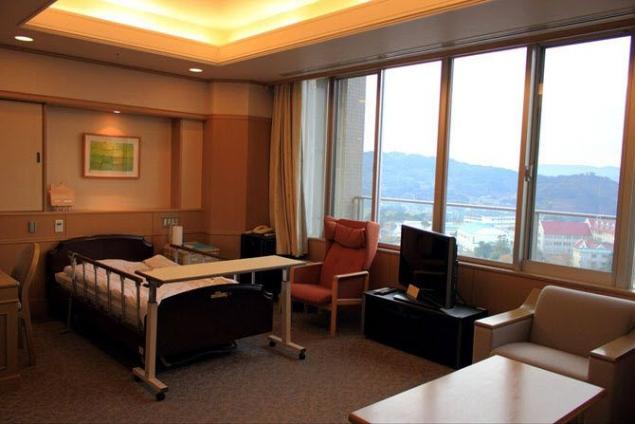
VIP-chamber, single. Staying in such conditions the patient needs to pay about 10,000 yen a day (about 4000 rubles).
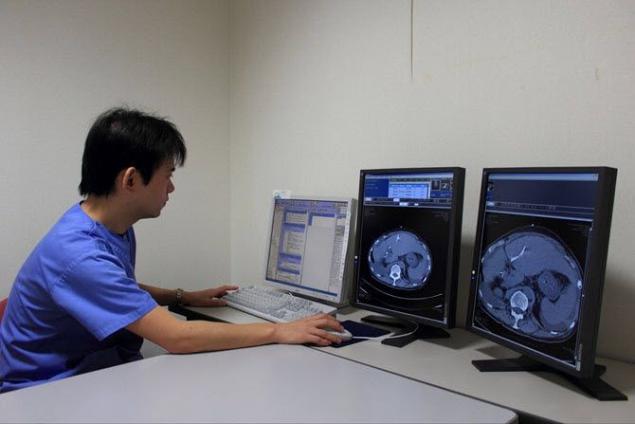
Dr. Nagaoka introduced me to the exponential electronic health records at the Department of Hepatology. The use of electronic medical records is very convenient, just one click you can see the dynamics of changes in the liver by computed tomography in recent years, or the result of an important analysis in the previous hospitalization. All data is stored on central servers, where they can be downloaded and edited in any of the dedicated and established everywhere in the center of the computers. Data access requires authorization and is available only for regular staff

Discussion patient of Dr. Nagaoka and work under the supervision of a senior resident Dr Bekki. Postgraduate medical education in Japan lasts much longer than in Kazakhstan and Russia. After graduation, graduate, depending on the chosen specialization must work up to 6 years in the profile clinic / office as an intern and resident, before proceeding to independent practice
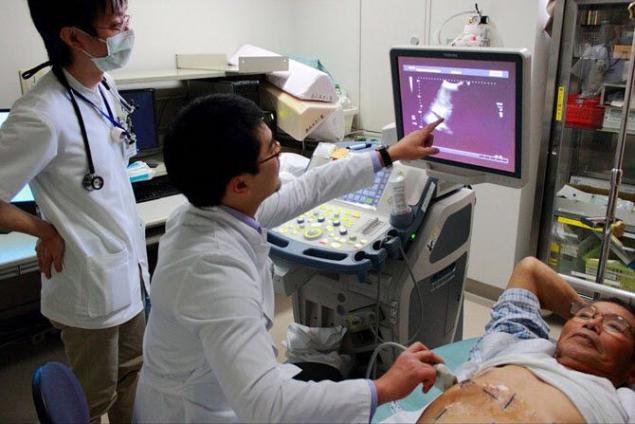
Tumor foci in the liver clearly visualized with ultrasound. In this case, one of the foci of metastatic gallbladder cancer. Given elderly primary tumor size and number of metastatic foci unfavorable prognosis. In Japan, there is no legislative provision for failure to inform patients about the prognosis of the disease, in each case is decided individually. Each patient being admitted to the hospital, fills out a questionnaire, noting the desire to be informed about the prognosis of the disease. AN-san originally wanted to stay in the dark about his prediction
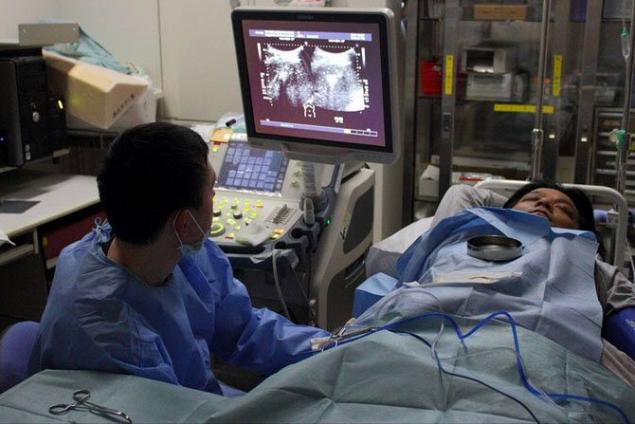
Dr. Bae performs radiofrequency ablation (RFA) of liver tumor focus in a mini-operating in the department. Under ultrasound guidance into the center of focus in the liver percutaneously introduced electrode tip that heats and destroys the tumor cells. The number of performed RFA is increasing every year, technology implementation own all doctors offices, in 2010, was carried out about 90 such procedures. Japanese hepatologists masterfully perform ultrasound, RFA of liver tumors, tissue biopsy of the liver and liver tumors, endoscopic ligation of esophageal varices and gastric, biliary tract stenting (percutaneous and endoscopic) and laparoscopic manipulation. All of the above post-Soviet space is the prerogative of Surgeons. Aware of the range of procedures performed and the associated need for knowledge and skills, unwittingly imbued with a deep sense of Japanese Hepatology respect

2-3 times a week, Professor Itoh, an expert center for pathology, giving me time, and I have been studying with him Pathomorphology (pathological changes in the organs at the cellular level) in liver diseases. Correct diagnosis is critical for treatment and prognosis of any disease and liver disease is no exception. In practice, the doctor hepatologist, there are occasions when an accurate diagnosis can not be established by laboratory or instrumental methods (X-ray, computed tomography, ultrasound, etc.). In many such cases, the ultimate truth, especially in clarifying the contentious issues is to get a piece of liver tissue by biopsy and study it under a microscope. Thus patomorfologija can help identify disease stage and degree of progression and prescribe the effective treatment time

The working day is over. At the exit from the clinic administrators notice the young clinic in suits and ties, carefully polishing the wall in the lobby. Later I learned that the next day was expected arrival of the official delegation from one of China's leading hospitals. Afternoon at the clinic are trained on viral hepatitis, which was attended by participants from developing countries. Evening planned a farewell dinner with the participants of the training in the traditional Japanese restaurant



Sunrise in the Land of the Rising Sun - truly one of the earliest in the world. Upland, constituting more than 75% of the country created during dawn and dusk exciting bizarre picture

Breakfast bachelor. For lack of yogurt and cottage cheese, must be content with a sandwich, cereal and favorite black tea with milk. "Aperitif" is a proven tool - morning newsletter

Virtually all of the sidewalks along the city roads throughout Japan are paved with tactile paths for the blind. Clinic 3-minute walk and the way you can go along the path, napping, "on autopilot"

National Nagasaki Medical Center (NMC) - one of the largest medical institutions of Kyushu. Center among the remaining 144 such institutions is part of the National Organization of hospitals in Japan. In the 31 department of the clinic center (10-storey building in the photo) at the same time may be more than 600 patients, clinic (3-storeyed building, communicating with the clinic) takes an average of 800 patients a day. Of the total number of permanent staff of 900 people at each of the 182 doctors an average of 3 nurses

"Green" in the literal and figurative sense parking. On my bike I still only here. Bike by the way, provides the clinic. As I have said, a clinic in a 3-minute walk from the house, but I go by bike, but if I have to in the evening to go somewhere

Entry and exit from the NMC maximum thought: some parking for two-wheeled transport avtomobileyi surround clinic with 3 sides, taxi duty front of the main output of the clock, and works like a clock Japanese public transport links the area with important points of the city

Receptionist clinic early in the morning. Here it is to greet each counter of the staff, regardless of whether you're familiar with him / her or not. "Good morning" in Japanese - "Ohio gozaimasu" greeting is usually accompanied by a bow depending on the status of the acclaimed, from slight nod of the head to a deep bow. Bow in Japan - a kind way of communication, it is not just a greeting, using it also would like to thank and apologize. It's hard to get used to the fact that a handshake is not taken

Cup of coffee and a croissant enrich your waiting in the lobby clinics NMC

On the second floor - offices specialists, diagnostic department and a mini-operating

Have specialists on the 3rd floor of the polyclinic life is in full swing

In this office for doctors Clinical Research Centre, located on the 2nd floor of the NMC is my workplace. In the laboratory, a research center I spend his scientific experiments, that is the main purpose of my stay here. I am studying liver disease and biliary tract, particularly the problem of viral hepatitis. This issue is very serious in many countries, but Kazakhstan is on the edge of a peculiar problem - according to the official WHO estimates, our country is a country with a high prevalence of hepatitis B and moderate - Hepatitis C

My workplace my eyes. Computer left - treasury, provides access to the local network clinics, to the shared printer and institutovsky online access to articles from leading medical journals in the world. My computer for security reasons to the center refused to connect, so you have to use both. In fairness it should be noted that all the other tables, too, at least for 2 computers for the same reason

Nursing post in the Division of Hepatology at the 8th floor of the clinic. Prior to the daily morning briefing at 8:45 with the head of the experiment time to see the schedule offices today - planned one operation, radiofrequency ablation of tumor focus in the liver and bypass patients. Private nursing room to room, common in clinics post-Soviet space is not here, they simply have no time to sit. Every 8 hours sisters follow each other day of their course more than 37,943,094
Weekly briefing in the office of Director General Clinical Research Center NMC, Professor Ishibashi (center), which controls the execution of all scientific publications in the walls of the clinic. The theme of the briefing - the course of my scientific experiment, discuss progress and next steps. Dr. Migita (left), head of the experiment, with whom I discussed all the working points, gives valuable practical guidance. After the first week of work at the center I have trained to perceive these meetings very seriously, while all painted up to minutes, so weekly briefings - almost the only opportunity to discuss important issues at the same time with both my heads

It is known that each person reacts differently to the same hepatitis B virus - some are cured thanks to its own immune system and not even notice it, while others develop chronic hepatitis B with prolonged favorable course, which practically does not prevent live in Third disease in a short time actively progressing to cirrhosis and liver cancer. The purpose of our scientific experiment - an attempt to identify the DNA genetic factors that contribute to an individual's susceptibility to hepatitis B. My mission - to highlight the desired region of DNA from the blood of patients with hepatitis B virus susceptibility coding and testing it for possible changes that can determine the degree of susceptibility to the same virus different people

The key to success of the experiment - diligence and accuracy. The reactions are carried out with volumes of material izmeryamym in microlitres, i.e. 1/1000 grams

Setting the thermocycler program of polymerase chain reaction (PCR). PCR allows you to copy and almost infinitely increase the amount needed for the study of the DNA fragment. During the reaction, the DNA in test tubes in a thermocycler periodically heated and cooled, allowing you to split a double-stranded structure, selecting and play it until the desired amount of material

The PCR program is given, the tubes loaded into the preheated to the desired temperature cycler, the apparatus can be run. About 2 hours the reaction product will be ready and you can start the second phase

Implementation of the second phase of the experiment - restriction analysis, new to me. One of the assistants Dr. Migitas long experience of laboratory work helps to avoid the phenomenon of "first pancake"

The final product, obtained by PCR and restriction analysis, electrophoresis is subjected, being immersed in a special gel. During electrophoresis, which was first described by the way in the MSU, move the DNA fragments in the gel, depending on the molecular weight due to the created electric field

The last and most exciting stage - digital processing of the agarose gel with the final product in a fluorescent image analyzer and test results. Minutes for the issue of the result on rereadings from an emotions load comparable to a few hours of painstaking preliminary laboratory work

In 3 samples (marked by arrow) revealed changes in the DNA molecule. After processing all the DNA samples of patients with hepatitis B, and there are several hundred, will be held the final analysis of the results, and based on a comparison with similar data from healthy people, summed up eventually. This study has the potential to shed light on the patterns of susceptibility to human hepatitis B virus and the severity of the disease at the genetic level

Lunch time in the clinic - from 12 to one in the afternoon, but the time frame is not fixed rigidly. I usually manage to escape home for lunch after an hour, but today every minute counts, and here I am in the dining room for the staff on the 10th floor. My usual menu - salad, miso soup Japanese national, grilled chicken, rice and a glass of water. Price question - 450 yen (about 180 rubles).

From the windows of the dining room with a breathtaking view of the city and the bay of Omura. Rush hour dinner was held in the dining room and very nelyudno. A few words about the table setting: a choice of sticks ("Hashi") or spoons and forks. There are certain rules for using chopsticks, which I, frankly, found only here in Japan, although eastern restaurants visited quite often: Hashi not be left stuck in rice, is not taken to indicate them to anyone, as well as gestures and cross. Soup to drink, and its contents to eat with chopsticks. At first it was strange to me that the Japanese are very often quite loud smack one's lips when eating soup, we do this with the public is unacceptable

In the cafeteria. Japanese service to pay tribute, generally recognized such sincere hospitality, friendliness and positive mood staff is hard to find anywhere else

On the 10th floor are also the restaurant for patients (pictured), a hall for tea ceremony-vendor machines for drinks and coin-operated laundry. Last - another proof of the traditional Japanese attention to detail, because for a long time are often close together with patients, especially with seriously ill and the possibility of a much-needed laundry service

-Vendor drinks machine, in this case as one of the indicators of food culture in Japan. Firstly, these devices are found absolutely everywhere, in every part of the sleepy provincial town in Japan you can be rest assured that you will not feel thirsty (provided that you have in your pockets 100-150 yen - 40-60 rubles). Second, a good half of the range occupied by green teas, which are here in abundance. The other half is represented by mineral water, juices, black tea with milk and coffee with milk (yes, plastic bottles). From carbonated drinks - only the "Coca-Cola", "Pepsi" and sometimes "Fanta»

Pride NMC- helicopter service. In the context of Japan, with its many small islands scattered - is not a luxury but a vital necessity. Now there is a center 2 helicopters, one designed for the transport of emergency patients, and the second is a helicopter taxi for doctors

Every year, NMC provides emergency assistance to more than 10 000 patients, of whom about 180 - with the help of helicopters

Mini-library in the research center - the dream of a hepatologist. Here in one room contains the most authoritative international publications on Hepatology. Half an hour after lunch before the bypass in Gastroenterological department will be spent here with the use of

Weekly bypassing the General Director of the Research Center Professor Ishibashi, head of the Department of Hepatology Abiru doctor and senior nurse branch.
M.-san is observed on the separation of cirrhosis in the outcome of hepatitis C more than 15 years. Regular monitoring and inspection can successfully control the disease. Chamber in the photo - the usual 4-seater, which is given to patients by default, due to the free insurance

S. San preparing for elective surgery for radiofrequency ablation (RFA) in the liver tumor focus (see. Description of the operation below). Over the past 8 years he held this procedure 5 times in connection with the appearance of new lesions and each time successfully. Although the patient, this operation is not new, Professor Ishibashi still found it necessary to pay attention to and encourage the patient. Chamber in the photo - Single, for her patients need to pay extra around 5,000 yen per night (about 2000 rubles)

F. Life-san 2 weeks ago literally hanging in the balance due to liver failure. Currently, his condition stabilized. The final touch in the treatment - removal of fluid from the right pleural cavity that has accumulated as a result of ascites (excessive accumulation of her in the abdomen), and we can discuss discharge home. The cause of ascites was liver cirrhosis, in which the normal liver tissue is replaced by fibrous connective tissue (scar tissue) and compacted liver prevents the outflow of blood vessels in the surrounding

VIP-chamber, single. Staying in such conditions the patient needs to pay about 10,000 yen a day (about 4000 rubles).

Dr. Nagaoka introduced me to the exponential electronic health records at the Department of Hepatology. The use of electronic medical records is very convenient, just one click you can see the dynamics of changes in the liver by computed tomography in recent years, or the result of an important analysis in the previous hospitalization. All data is stored on central servers, where they can be downloaded and edited in any of the dedicated and established everywhere in the center of the computers. Data access requires authorization and is available only for regular staff

Discussion patient of Dr. Nagaoka and work under the supervision of a senior resident Dr Bekki. Postgraduate medical education in Japan lasts much longer than in Kazakhstan and Russia. After graduation, graduate, depending on the chosen specialization must work up to 6 years in the profile clinic / office as an intern and resident, before proceeding to independent practice

Tumor foci in the liver clearly visualized with ultrasound. In this case, one of the foci of metastatic gallbladder cancer. Given elderly primary tumor size and number of metastatic foci unfavorable prognosis. In Japan, there is no legislative provision for failure to inform patients about the prognosis of the disease, in each case is decided individually. Each patient being admitted to the hospital, fills out a questionnaire, noting the desire to be informed about the prognosis of the disease. AN-san originally wanted to stay in the dark about his prediction

Dr. Bae performs radiofrequency ablation (RFA) of liver tumor focus in a mini-operating in the department. Under ultrasound guidance into the center of focus in the liver percutaneously introduced electrode tip that heats and destroys the tumor cells. The number of performed RFA is increasing every year, technology implementation own all doctors offices, in 2010, was carried out about 90 such procedures. Japanese hepatologists masterfully perform ultrasound, RFA of liver tumors, tissue biopsy of the liver and liver tumors, endoscopic ligation of esophageal varices and gastric, biliary tract stenting (percutaneous and endoscopic) and laparoscopic manipulation. All of the above post-Soviet space is the prerogative of Surgeons. Aware of the range of procedures performed and the associated need for knowledge and skills, unwittingly imbued with a deep sense of Japanese Hepatology respect

2-3 times a week, Professor Itoh, an expert center for pathology, giving me time, and I have been studying with him Pathomorphology (pathological changes in the organs at the cellular level) in liver diseases. Correct diagnosis is critical for treatment and prognosis of any disease and liver disease is no exception. In practice, the doctor hepatologist, there are occasions when an accurate diagnosis can not be established by laboratory or instrumental methods (X-ray, computed tomography, ultrasound, etc.). In many such cases, the ultimate truth, especially in clarifying the contentious issues is to get a piece of liver tissue by biopsy and study it under a microscope. Thus patomorfologija can help identify disease stage and degree of progression and prescribe the effective treatment time

The working day is over. At the exit from the clinic administrators notice the young clinic in suits and ties, carefully polishing the wall in the lobby. Later I learned that the next day was expected arrival of the official delegation from one of China's leading hospitals. Afternoon at the clinic are trained on viral hepatitis, which was attended by participants from developing countries. Evening planned a farewell dinner with the participants of the training in the traditional Japanese restaurant

Tags
See also
A day in the life of the confectioner in France
A day in the life of Turner borer
A day in the life on the trawler (41 photos)
A day in the life of the American dentist (47 photos)
A day in the life of cardiac clinic
A day in the life of Lugansk Saporta
A day in the life of a programmer
Half his life in a train - one day in the life of the underground
















